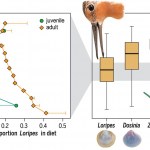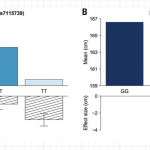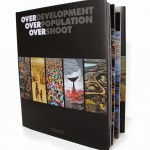adaptation
You've heard the phrase, "Nothing in biology makes sense except in the light of evolution," an insightful phrase penned in 1972 by Theodosius Dobzhansky. I would like to add a second part to that phrase, and it goes like this: "... and, nothing in evolution makes sense except in the light of co-evolution." This would hardly be an exaggeration, and it can hardly be better exemplified than with examples from migratory birds. Migratory birds have to be adapted to at least three different ecological settings. They breed in one area, migrate (and often spend considerable time) through another…
There is a new paper in Science linking genetic variation in people living in Greenland with long term selection for managing a marine-oriented diet, affecting stature, weight, and probably, physiological processing of omega-3 polyunsaturated fatty acids (PUFAs).
The vast majority of the variation we seen in stature (height) among humans is not genetic. That is a fact hard to swallow by so many of us who were told in biology class that "height is a complex genetic trait with many genes affecting it." It also seems wrong because the classic examples of variation in stature, the Pygmies of…
August 13th was Earth Overshoot Day. The correct date, if calculated precisely, would come earlier and earlier each year, the current choice is just an approximation.
This year, the year 2015, by sometime around August 13th, humanity had consumed as much of what we require from the lands and seas as our planet can sustainabley provide in an entire year. That is another way of expressing the fact that at current consumption rates, humanity requires 1.6 planet earth's worth of fruits and vegetables, meat, fish, wood and other organic materials. It is a remarkable annual deficit, and if it is…
I just watched a neat video describing how animals adapt to their environments to increase survival:
One of the most important and threatening risks of climate change is sea-level rise (SLR). The mechanisms are well understood, and the direction of changes in sea-level is highly certain – it is rising and the rate of rise will accelerate. There remain plenty of uncertainties (i.e., a range of possible outcomes) about the timing and rate of rise that have to do with how fast we continue to put greenhouse gases in the atmosphere, the responses of (especially) ice sheets in Greenland and Antarctica, and the sensitivity of the climate.
Even little changes can have big consequences. As we saw…
M. is back with her view from how the class is going - after an amazingly brief pause to give birth to a new baby!
o my week 4 update was simply labor, labor and more labor. We finally had the baby! We are home and healthy. And I get to brag that he was born in a bathtub (it was a water birth)! Do you think he will appreciate that when he's twelve? After another sleepy week off, I am back with week 6.
The class has been slowly zeroing in on brainstorming solutions to some of the more mundane issues of low power living. Things like sustainable rat population control, stockpiling…
On January 1, it was 48 degrees on my farm. My sons were at the playground, dressed in sweatshirts and jeans, rather than winter coats and mittens. Their ice skates had yet to be used this year. Their sleds haven't even come out of the garage. Walking out in the warm weather among the goats, I noticed my cowslips and primroses are up and there are buds on the pussy willows.
On the farm, we measure the severity of the winter by the final full barn cleaning before spring - the last one before heavy snow and ice make it impossible to get a wheelbarrow in and out of the barn. In a cold…
Today, I took out the trash. I may or may not have taken the trash out last week, but I can tell you that the last time I did take it out, whenever it was, I had to drag the trash barrel across ice. Yesterday I went to the gym without a coat or jacket. That made me have to decide if I wanted to go to the locker room to stow the contents of my pockets (car keys, etc.) or just keep those things in my pocket. The grass outside is green. We expect snow on Friday.
Where I grew up, in what is now known among gardeners and cooperative extension agents as Zone 5b (though a short drive from a…
As in the example I just highlighted, we climate mitigation advocates are frequently attacked for alledgedly not wanting to do anything to promote or help people adapt to changes that are after all already underway.
This post is meant to change that lack of balance on A Few Things Ill Considered.
To all and sundry, I bring to your attention the definitive guide to adaptation in the face of global climate disruption:
(This is a real book, by the way!)
For those who like to skip to the end, here is the back cover. And speaking of skip, thanks to him for bringing this to my attention, a good…
So over at Keith Kloor's place, we see Keith read a comment of Michael Tobis', (read it for your self here) in which he says: "Adaptation is crucial" and "adaptation and mitigation are not a tradeoff. They are two faces of the same coin." along with a whole bunch of, typical for Tobis, nuanced and intelligent points.
What does Keith want his readers to take away from that? That Michael Tobis is a hypocrite who does not really care about suffering humanity and his whole schtick is "the typical zero-sum talking point, that mitigation (curbing carbon emissions) has to take precedence over…
A few days ago I discussed a new paper which explores the patterns of natural selection in the genome of the X chromosome. As you know the X is "carried" disproportionately by females, as males have only one copy, so it offers up an interesting window into evolutionary dynamics (see The Red Queen for a popular treatment). Today Dienekes points me to a new paper in Genome Biology which puts the focus on the X chromosome again, Characterization of X-Linked SNP genotypic variation in globally-distributed human populations:
Background
The transmission pattern of the human X chromosome reduces its…
Changes in human diet driven by cultural evolution seem to be at the root of many relatively recently emerged patterns of genetic variation. In particular, lactase persistence and varied production of amylase are two well known cases. Both of these new evolutionary genetic developments are responses to the shift toward carbohydrates over the last 10,000 years as mainstays of caloric intake. Rice and wheat serve as the foundations of much of human civilization. It is notable that both China and India are divided into rice and wheat (or millet) belts, so essential are modes of agriculture in…
VIEWING a stimulus for a prolonged period of time results in a bias in the perception of a stimulus viewed afterwards. For example, after looking at a moving stimulus for some time, a stationary stimulus that is viewed subsequently appears to drift in the opposite direction. These after-effects reveal to us the properties of our perceptual system. They occur because the neurons which are sensitive to the initial stimulus re-calibrate their responses; they adapt to compensate for the earlier enduring stimulus, and so can continue to encode current stimuli efficiently.
It was long thought that…
The Properties of Adaptive Walks in Evolving Populations of Fungus:
The rarity of beneficial mutations has frustrated efforts to develop a quantitative theory of adaptation. Recent models of adaptive walks, the sequential substitution of beneficial mutations by selection, make two compelling predictions: adaptive walks should be short, and fitness increases should become exponentially smaller as successive mutations fix. We estimated the number and fitness effects of beneficial mutations in each of 118 replicate lineages of Aspergillus nidulans evolving for approximately 800 generations at…
greenman has done a fine job of debunking the various exagerations, misrepresentations and lies circulating about the recent Swiftwacking of CRU (aka Climategate).
I recommend having a look, below:
Well, I don't quite know about that, but that's the sort of take-away from a new paper in PLoS Biology which looks at the downsides of female attractiveness. A Cost of Sexual Attractiveness to High-Fitness Females:
Adaptive mate choice by females is an important component of sexual selection in many species. The evolutionary consequences of male mate preferences, however, have received relatively little study, especially in the context of sexual conflict, where males often harm their mates. Here, we describe a new and counterintuitive cost of sexual selection in species with both male mate…
A few months ago I reviewed a paper which examined the various complexities of interpreting signals of natural selection from recently developed genomic tests in response to the avalanche of human sequence data. In the paper, Signals of recent positive selection in a worldwide sample of human populations, the authors state:
We find that putatively selected haplotypes tend to be shared among geographically close populations. In principle, this could be due to issues of statistical power: broad geographical groupings share a demographic history and thus have similar power profiles. However,…
400-500 years ago in the midst of the Great Dying somewhere the indigenous inhabitants of the New World suffered mortality rates on the order of 90-95%. This was almost certainly due to the facts of evolutionary history; the indigenous peoples had little defense against Eurasian pathogens. A result has been the reality that most of the New World is inhabited by European, African or mixed populations. But there are exceptions. In Mesoamerica there is still an indigenous dominated region from southern Mexico into the highlands of Guatemala. More substantially the highlands of the Andes, and…
Guest post from het, provider of the weekly feature "Another week of GW News"
Sandbag Central
(source: Boston.com)
When I see scenes like the 'sandbag central' Fargo stadium --- thousands of people shovelling sand, making and piling sandbags, fighting together for their city --- my heart swells. It is the community of shared adversity.
CBC-TV had a camera crew wandering around the stadium interviewing people and they zeroed in on one little blonde haired girl of 7 or 8 years. "Why are you doing this?" asked the interviewer. "For my city, for my family," said the little girl. But the thing…
From New Scientist, here is a short article discussing five cases of small populations forced to relocate or plan to relocate due to sea level rise, caused by climate change.
It is a little anti-intuative to think that the 15-25 cm or so rise we have observed on average over the last hundred years could affect an island, even one whose highest point is only 2.4 metres above sea level, like the Maldives.
The relevant thing to remember is that it is not pure and simple submersion of existing land that is at work, rather it is erosion accelerated by both direct and indirect means. As waves lap…



